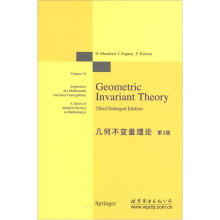几何不变量理论(第3版)

目 录内容简介
This edition of the book has been extended to take account of one of these developments, one which was just hinted at in the second edition. A close and very fruitful relationship has been discovered between geometric invariant theory for quasi projective complex varieties and the moment map in Symplectic geometry, and a chapter has been added describing this relationship and some of its applications. In an infinite-dimensional setting the moment map links geometric invariant theory and Yang-Mills theory, which has of course been the focus of much attention among mathematicians over the last fifteen years.
In style this extra chapter is closer to the appendices added in the second edition than to the original text. In particular no proofs are given where satisfactory references exist.
In style this extra chapter is closer to the appendices added in the second edition than to the original text. In particular no proofs are given where satisfactory references exist.
比价列表价格走势
1人想要
公众号、微信群
 缺书网
缺书网微信公众号
 扫码进群
扫码进群实时获取购书优惠







